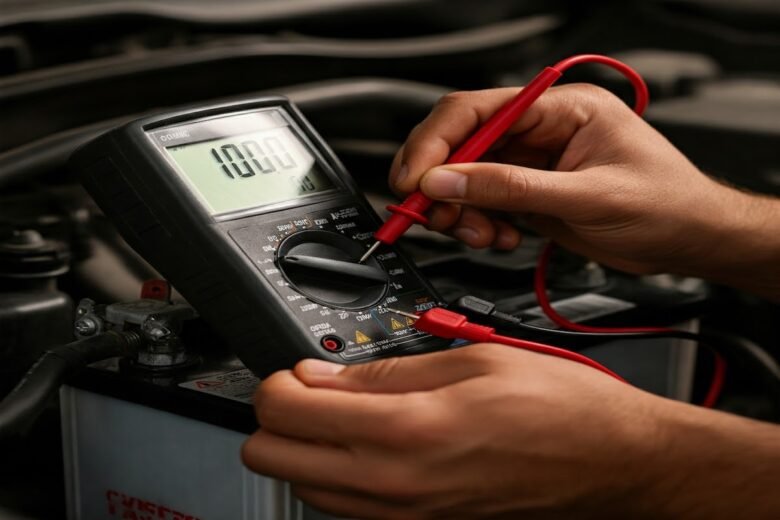Electrical issues in cars—like dead batteries, faulty alternators, or blown fuses—can leave you stranded or dim your lights. A multimeter, a versatile tool, helps pinpoint these problems accurately. This guide is for DIY car owners with beginner to intermediate skills, explaining how to use a multimeter to diagnose common car electrical issues. With step-by-step instructions, safety precautions, and practical tips, you’ll gain the confidence to troubleshoot and fix problems, saving time and money.
Why Diagnosing Electrical Issues Matters
Car electrical systems power critical components: batteries start engines, alternators charge systems, and fuses protect circuits. Faults cause breakdowns—20% of roadside calls involve electrical failures, per AAA—and repairs cost $50–$1,000, per automotive estimates. For example, a weak alternator can ruin a battery ($100–$200), while a short circuit risks fires ($500–$5,000). Diagnosing with a multimeter takes 15–60 minutes and costs $10–$50 for the tool, saving $100–$500 in shop diagnostics. Easier than rewiring but requiring precision, it’s ideal for DIYers learning electrical basics.
Tools and Materials Needed
You’ll need minimal items to diagnose electrical issues:
- Primary Tool:
- Multimeter (digital, $10–$50, with DC voltage, continuity, and resistance modes)
- Supporting Tools:
- Owner’s manual (for fuse box and wiring specs)
- Flashlight ($5–$15, for visibility)
- Wire brush ($3–$5, to clean terminals)
- Clean rags ($3–$5)
- For Safety and Access:
- Gloves (nitrile, $5–$10, for insulation)
- Safety glasses ($5–$10, against sparks)
- Screwdriver (flathead/Phillips, $5–$10, for panels)
- Fuse puller ($2–$5, often in fuse box)
- Optional:
- Alligator clips ($3–$10, for hands-free probing)
- Notebook (to log readings)
- OBD-II scanner ($20–$50, for related codes)
- Replacement fuses ($5–$15, assorted)
- Electrical tape ($3–$5, for minor fixes)
Choose a reliable multimeter (e.g., Innova, Extech, AstroAI) with auto-ranging for ease or manual for control. Check your manual for specifics (e.g., battery location in a 2020 Toyota Corolla, fuse box in a 2018 Ford F-150). Keep spare batteries (9V or AA) for the multimeter.
Safety First: Working with Electrical Systems
Car electrical systems use 12V DC, safer than household AC but still risky. Follow these precautions:
- Turn Off the Engine: Remove keys to prevent surges or starts.
- Wear Protective Gear: Gloves and safety glasses shield against sparks or acid ($50–$500 medical).
- Avoid Water: Wet hands or surfaces increase shock risk, even at low voltage.
- Disconnect Battery for Repairs: Remove negative terminal (black, -) unless testing requires power ($5–$50 damage).
- Use Insulated Tools: Prevent shorts—metal screwdrivers spark ($5–$200).
- Work in a Well-Lit Area: Dim light causes errors—use a flashlight.
- Don’t Touch Live Wires: Bare wires can arc, damaging components ($50–$500).
- Know Your Multimeter: Set correct modes (e.g., DC, not AC)—wrong settings fry the tool ($10–$50).
If new to electrical work, practice on a 9V battery and watch videos (e.g., “multimeter car basics”). Keep a phone handy for specs or emergencies.
Step 1: Understanding Your Multimeter
Learn the multimeter’s functions to diagnose accurately:
- Key Features:
- Display: Shows readings (e.g., 12.6V, ohms).
- Dial/Buttons: Select modes (DC voltage, continuity, resistance).
- Probes: Red (positive), black (negative) for testing.
- Modes:
- DC Voltage (V⎓): Measures battery, alternator (0–20V range).
- Continuity (🔊): Checks fuses, wires for breaks (beeps if connected).
- Resistance (Ω): Tests sensors or circuits (ohms).
- DC Amps (A): Rarely used (dangerous for high current, avoid unless advanced).
- Setup:
- Insert probes: red to V/Ω, black to COM.
- Turn on, select mode (e.g., 20V DC for battery).
- Test on a known source (e.g., AA battery, ~1.5V) to confirm accuracy.
- Common Settings:
- Battery: 20V DC.
- Alternator: 20V DC.
- Fuses/Wires: Continuity or ohms.
- Sensors: Resistance (check manual, e.g., 500–2000Ω for oxygen sensor).
Pro Tip: Auto-ranging multimeters simplify mode selection. Log settings used (e.g., “20V DC, battery, Nov 2025”) to repeat tests.
Step 2: Diagnosing Common Electrical Issues
Use the multimeter to test four frequent problems: battery, alternator, fuses, and wiring.
Test 1: Battery Health
A weak battery causes slow cranks or no starts.
- Prepare:
- Engine off, key out, hood open.
- Locate battery (e.g., engine bay for 2021 Honda Civic, trunk for some BMWs).
- Clean terminals with a wire brush if corroded.
- Set Multimeter:
- Select 20V DC.
- Touch red probe to positive (+), black to negative (-).
- Measure Voltage:
- 12.5–12.8V: Healthy, fully charged.
- 12.2–12.4V: Partially discharged, charge soon.
- Below 12.2V: Bad, charge or replace ($100–$200).
- Below 10V: Dead, test alternator or cables.
- Cranking Test (Optional):
- Have a helper crank the engine (10 seconds).
- Voltage should stay above 9.6V—lower means weak battery or starter ($200–$800).
- Check Connections:
- Test voltage at cable clamps—same as terminals. Lower readings mean loose or corroded cables ($5–$50).
Note: If voltage is low, charge for 4–8 hours and retest. Persistent issues suggest alternator or parasitic drain.
Test 2: Alternator Output
A faulty alternator fails to charge the battery, dimming lights or stalling.
- Prepare:
- Start engine, let idle (1000–1500 RPM).
- Turn on headlights to load system.
- Set Multimeter:
- Select 20V DC.
- Touch probes to battery terminals (red to +, black to -).
- Measure Running Voltage:
- 13.8–14.8V: Alternator is charging correctly.
- Below 13.5V: Weak alternator, failing diode, or belt ($200–$800).
- Above 15V: Overcharging, bad regulator ($50–$200).
- 12.6V or less: Not charging, test connections or replace ($200–$800).
- Load Test:
- Turn on AC, wipers, radio—voltage should stay 13.5–14.5V.
- Drops below 13V suggest alternator strain.
- Check Belt:
- Visually inspect alternator belt—cracks or looseness reduce output ($20–$50).
Note: If faulty, stop driving—battery drains in 30–60 minutes. Tighten cables before replacing ($5–$50).
Test 3: Fuse Integrity
Blown fuses disable systems (e.g., radio, lights).
- Prepare:
- Engine off, locate fuse box (e.g., under dash for 2019 Subaru Outback, engine bay for 2020 Chevy Silverado).
- Check manual or cover for fuse chart (e.g., “headlights, 15A, #12”).
- Set Multimeter:
- Select continuity (beep) or ohms (0Ω = good).
- Remove fuse with puller or fingers (dry hands).
- Test Fuse:
- Touch probes to both fuse prongs.
- Beep or 0Ω: Fuse is good.
- No beep or infinite Ω: Blown, replace with same rating ($0.50–$5).
- Visually confirm: broken or blackened strip means blown.
- Check Circuit:
- With fuse out, set to 20V DC, probe fuse box slots.
- 12V on one side, 0V on other: Normal (circuit off).
- No voltage: Check wiring or relay ($50–$500).
- 12V both sides (circuit on): Possible short ($200–$1,000).
Note: Repeated blowing means deeper issues (e.g., short, faulty component). Don’t use higher-rated fuses—fires risk ($500–$5,000).
Test 4: Wiring and Ground Connections
Bad wires or grounds cause erratic systems (e.g., flickering lights).
- Prepare:
- Identify affected system (e.g., turn signal).
- Trace wires visually (manual or diagrams, e.g., “Haynes manual, 2022 Nissan Altima”).
- Set Multimeter:
- Use continuity for wire breaks, 20V DC for power.
- Test Wires:
- Continuity: Disconnect battery, probe wire ends (e.g., light to switch).
- Beep or 0Ω: Intact.
- No beep: Broken, repair or replace ($50–$500).
- Voltage: Key on, probe wire at component (e.g., light socket).
- 12V: Power present.
- 0V: Check fuse, switch, or break ($50–$500).
- Continuity: Disconnect battery, probe wire ends (e.g., light to switch).
- Test Grounds:
- Find ground point (e.g., bolt to chassis near battery).
- Set to 20V DC, touch red to battery positive, black to ground.
- 0–0.3V: Good ground.
- Above 0.5V: Corroded, clean or relocate ($5–$50).
- Inspect Visually:
- Look for frayed insulation, melted wires, or loose connectors—tape minor damage ($3–$5).
Note: Complex wiring (e.g., CAN bus) needs pro diagnostics ($200–$1,000). Stop if unsure.
Step 3: Interpreting Results and Next Steps
Analyze findings to act:
- Battery:
- Low voltage: Charge 8–12 hours, retest. If still low, replace ($100–$200).
- Good but no crank: Test starter or solenoid ($200–$800).
- Alternator:
- Weak output: Tighten belt, check connections ($5–$50). If persistent, replace ($200–$800).
- Overcharging: Replace regulator or alternator ($50–$200).
- Fuses:
- Blown: Replace and test system. Recurrence needs wiring check ($50–$500).
- Intact but no power: Trace relay or switch ($50–$200).
- Wiring/Grounds:
- Breaks: Splice or replace ($50–$500).
- Bad ground: Clean with wire brush, rebolt ($5–$50).
- Shorts: Isolate with tape or replace ($200–$1,000).
- Log Results:
- Note readings (e.g., “Battery 12.3V, alternator 14.2V, Dec 2025”) to track trends.
- Save photos of setups for reference.
- Drive Test:
- Drive 5–10 miles, checking lights, radio, or affected systems.
- Monitor warnings (e.g., battery light, $200–$800).
- If issues persist, retest or consult a mechanic.
Pro Tip: Use an OBD-II scanner for codes (e.g., P0562 for low voltage, $50–$1,000) to confirm findings.
Step 4: Maintaining Your Multimeter
Keep it reliable:
- Store Properly:
- Keep in a dry case—moisture ruins ($10–$50).
- Remove probes to avoid bending.
- Check Battery:
- Replace 9V or AA if display dims ($3–$5).
- Test yearly with a known source (e.g., 12V adapter).
- Clean Probes:
- Wipe with alcohol to remove grease ($3–$5).
- Check for wear—replace if frayed ($5–$10).
- Calibrate (Optional):
- Compare to a known voltage yearly—recalibrate if off ($20–$50, pro service).
Tip: Save the manual for mode references, and keep spare fuses for the multimeter ($1–$5).
Common Mistakes to Avoid
- Wrong Mode: AC on DC fries multimeter ($10–$50).
- Live Circuits: Probing with power on sparks ($5–$200).
- No Gloves: Acid or shocks injure ($50–$500).
- Ignoring Grounds: Bad grounds mimic faults ($50–$500).
- Skipping Logs: Forgetting readings delays fixes ($100–$1,000).
- High Amps: Amp mode on battery burns tool ($10–$50).
When to Seek Professional Help
Most tests are DIY-friendly, but see a mechanic if:
- Complex Wiring: CAN bus or ECU issues ($200–$2,000).
- Alternator Fails: Removal needs tools ($200–$800).
- Short Circuits: Hidden shorts risk fires ($500–$5,000).
- Persistent Codes: Scanner shows major faults ($500–$3,000).
- Unsure Readings: Mixed results need oscilloscopes ($200–$1,000).
Shops charge $100–$500 for diagnostics, but DIY saves with a multimeter.
Additional Tips for Electrical Diagnosis
- Start Simple: Test battery first, then alternator, fuses ($0–$50).
- Check Grounds Early: Loose bolts mimic failures ($5–$50).
- Use Diagrams: Find wiring layouts online (e.g., “2020 Jeep Cherokee diagram”, $0–$20).
- Keep Spares: Store fuses and bulbs ($5–$30).
- Test in Order: Battery → alternator → fuses → wires to avoid misdiagnosis.
- Practice: Test household batteries to learn ($0–$5).
Environmental and Cost Benefits
Diagnosing issues prevents waste: a bad battery (7 pounds) or alternator (15 pounds) avoids landfills. It saves fuel by 2–5%, or 20–50 pounds of CO2 yearly, per EPA. DIY cuts $100–$500 per job, and a multimeter ($10–$50) lasts years. Recycling batteries at AutoZone ($5–$10 credit) reduces pollution—one battery contaminates soil for decades.
Conclusion
Using a multimeter to diagnose car electrical issues empowers you to fix problems like weak batteries or blown fuses confidently. By testing voltage, continuity, and connections, you’ll pinpoint faults and avoid breakdowns. This guide suits beginners to intermediates, while tips like logging readings or checking grounds help all DIYers.
Next, try tasks like fuse replacement or battery maintenance to grow skills (see related guides). If issues persist, consult a mechanic. With a multimeter and an hour, you’re set for a powered-up ride!




